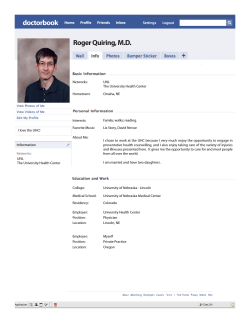
Center for Ecology, Evolution & Management of Pesticide
Center for Ecology, Evolution & Management of Pesticide Resistance CEEMPR& 1.3 Project Title: Predicting risk of rootworm injury to corn in the Midwestern U.S. Principal Investigators: Robert Wright, Thomas Hunt, Julie Peterson, and Jeff Bradshaw Site: University of Nebraska Site Director: Thomas E. Hunt Project Type: New Proposed Budget: $50,000 for first year ($150,000 total for 3 years) Estimated Start Date: March 1, 2016 Estimated Knowledge Transfer Date: March 1, 2017 Objective. Develop maps with publically available data that predict the risk of damage by corn rootworm larvae. Experimental plan. Maps of Nebraska will be developed identifying areas with continuous corn (corn-corn-corn cropping sequence), using the USDA-‐NASS Cropland Data Layers (CDL) (see example below) [1]. Center for Ecology, Evolution & Management of Pesticide Resistance CEEMPR& The USDA-‐NASS CDL is a publicly available geospatial raster dataset showing crop-‐specific land cover classification that focuses primarily on mapping cultivated fields and providing an update on the agriculture landscape in the United States. Soil texture data will be obtained from USDA-NRCS and added as an additional data layer. NRCS has a new soil data format called gSSURGO (10m grid) which allows us to map the entire state with one SSURGO data set. Based on these data and other available data suggested by Turpin et al. [2], a multiple factor model will be developed to predict rootworm risk. Four fields with predicted high rootworm risk will be selected from each of four regions of the state (northeast, southeast/south central, west central and panhandle. One field from each region predicted to have low rootworm risk will also be included. Data to be collected from each field will be hybrid planted, planting date, insecticide use, and irrigation/rainfall amount during the period of larval development. If a Bt rootworm corn hybrid with a structured refuge is planted in a field, data will be collected from 4 areas in the refuge. If not, 4 areas in each field will be replanted to a non-‐Bt hybrid. Data will be collected on adult emergence and 0-‐3 node-‐injury root ratings of plants. These data will be used to validate the model, and suggest changes to improve model accuracy. Model development and validation will occur over three growing seasons. Once a model is validated for use in Nebraska, future efforts will be to test its accuracy in other Midwestern states. Related work elsewhere. Turpin and Peters [3] conducted greenhouse studies which documented that soil texture had significant effects on larval survival of western corn rootworm. Soils with higher % clay resulted in higher survival of larvae. As % clay increases in a soil, % sand decreases. Sand particles are thought to abrade the larval cuticle, promote increased desiccation of larvae and reduced survival. Turpin et al. [2] measured edaphic and agronomic factors influencing corn yields in fields situated at random sites within 15 Iowa counties. Corn roots from each site were rated for rootworm damage each year. The rootworm portion of the study was conducted over 6 years (1964-‐ 69), Factors influencing root-‐damage ratings were determined using multiple regression techniques applied through stepwise model-‐ building procedures and path analysis. A prediction equation for root worm damage was developed based on significant edaphic and agronomic factors available to the farmer at planting time. Important factors influencing rootworm-‐damage ratings were percentage of clay in soil, soil potassium, soil phosphorus, slope of field, drainage of field, planting dale, and plant population. How this project is different: Previously data were not publicly available on cropping sequences across the U.S. on an annual basis. Team. Robert Wright, Thomas Hunt, Jeffrey Bradshaw, Julie Peterson and a graduate student to be recruited (UNL). Milestones and Deliverables for the current proposed year. Develop a map of Nebraska identifying areas with corn-corn-corn cropping sequence, and varying soil textures using USDANASS and USDA-NRCS data from 2014. Identify potential fields, choose cooperating growers, Center for Ecology, Evolution & Management of Pesticide Resistance CEEMPR& and collect additional relevant data (e.g., 2014 hybrid, planting date, insecticide use). Collect field data in 2015. How the project may be transformative and/or benefit society: Better identification of potential risk for rootworm injury will allow for more targeted educational programs, and site-specific selection of BMPs for rootworm management, potentially increasing grower profits, and reducing environmental impacts of management practices. Research Areas of expertise need for project success: UNL has Entomology faculty located across the state working in corn entomology who can contribute to this study. Technical support with expertise in GIS and map making is available through the UNL Agronomy-Horticulture Department for development of maps based on data from USDA-NASS and other public sources. Potential member Company Benefits: Development of validated maps of areas with a high risk for rootworm injury will help direct company grower education programs to encourage grower adoption of IRM practices, and monitoring programs for rootworm susceptibility changes over time. Progress to Date: n/a References: 1. Turpin, F. T. & D. C. Peters. 1971. Survival of southern and western corn rootworm larvae in relation to soil texture. J. Econ. Entomol. 64: 1448-1451. 2. Turpin, F. T., Dumenh, L. C. & D. C. Peters. 1972. Edaphic and agronomic characters that affect potential for rootworm damage to corn in Iowa. J. Econ. Entomol. 65: 1615-1619. 3. USDA-NASS. 2014. Cropland data layer. http://nassgeodata.gmu.edu/CropScape/
© Copyright 2025









